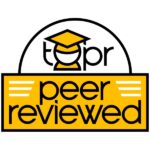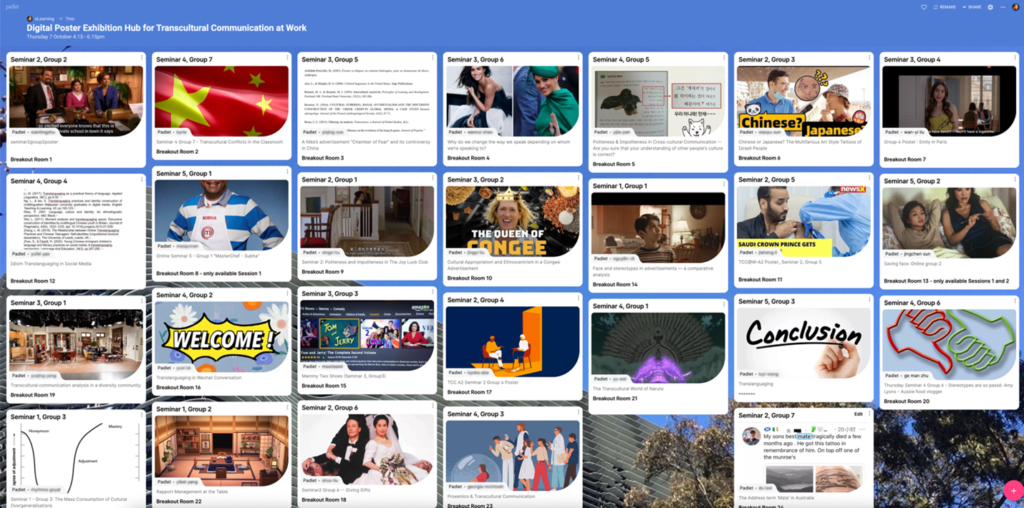Tags: Assessment, Group Work, Interaction, Padlet, Peer-Reviewed Entry, Poster

Description
Assessing knowledge for individual students online can be a challenge, let alone when in groups. Add the remote learning conditions of the COVID-19 pandemic, and the challenges increase even more to offer accessible, inclusive, and equitable learning experiences.
Technologies such as Padlet allow remote learners to virtually collaborate on a single product. One such product is a virtual poster. Posters are an alternative way of presenting information, common in academic contexts and in many workplaces.
Link to example artifact(s)
Course: LING90026: Transcultural Communication at Work.
Learning Designer/Learning Technologist: Meredith Hinze in collaboration with Subject Coordinators in the Master of Applied Linguistics program, The University of Melbourne.
Students in a graduate Linguistics subject on the transcultural communication at the intersection of cultural, linguistic, ethnic and religious boundaries, worked in small groups to create a multimodal poster that explores and applies concepts/frameworks effectively in interpreting ‘text/s’ /communicative artefacts.
Before the COVID-19 pandemic, the student groups created a physical poster and presented it at an on-campus event. During the pandemic, the assessment activity was modified to become a Digital Poster, with an online event. Padlet was chosen as the platform both for the students to create the posters and to enable students to work collaboratively from wherever they were located. Padlet is a web-based tool that supports virtual brainstorming, collation and collaboration activities (Beltrán-Martín, 2019). Padlet supports rich media, including the creation of video and audio recordings within a post. Posts dynamically update in real time and are in draft format until “published”. Padlet was used to make this online group assessment a more inclusive, equitable student learning experience and accessible to the entire cohort, independent of learning mode.
Students are asked to think creatively about what texts (communicative artefacts) might exemplify interesting issues in transcultural communication. Working in small groups, students prepare a multimodal poster that explores one type of “text” in terms of transcultural communication that is grounded in theory and suggests areas for further research. It can be written, audio, visual, print, electronic or multimodal. Examples could include a YouTube video, a transcript of recorded interaction, an advertisement, a scene from a movie.
Students were supported with scaffolded resources in a Padlet wall, including example posters. Teaching staff were supported in learning Padlet, through making several example posters themselves, which then formed part of the scaffolded resources available to support students.
To facilitate the online poster presentation event, a “nested” Padlet was created as a Virtual Exhibition Poster Hub (Figure 1), displaying and linking to each group’s (Padlet) poster and mapping each group’s poster to a Zoom breakout room number. Students, teaching staff and invited academics from related disciplines were able to freely move between Zoom breakout rooms to view posters, with a student from each of the project groups rostered at a designated time to be in a specific zoom breakout room to discuss their poster. Using a “master” Padlet wall and nesting other Padlet walls by adding them as posts, has the affordance of displaying and giving easy access to digital resources in one place. This is a useful strategy replicable for other digital creation or curated assessment tasks.

One of the criteria for the student posters was to raise two pertinent questions to generate feedback/comments. Students were tasked with providing feedback on several posters during the online event. The final assessment task was an individual written critical response, going beyond the topic of the poster and reflecting on the audience’s key issues, questions and feedback comments received.
Results
The clear benefit of this strategy was that students could showcase their research outcomes in a highly interactive way through online delivery during the remote learning conditions of the pandemic. The use of Padlet to adapt conference style posters to digital posters, gave students a wider range of possibilities than they would have from the traditional print poster format, including the ability to embed different kinds of media, create more dynamic layouts and interact with other students asynchronously via comments.
The Poster Exhibition event was a great use of self-selected Zoom breakout rooms that allowed students to engage with each other in real time about their research. Teaching staff found this provided a space for much more dynamic discussion than had been achieved in the large student zoom seminars or even in the standard discussion group breakout rooms used during seminar teaching. Additionally, as the whole cohort was involved, students got to interact with students from other seminar groups.
One of the main challenges reported by teaching staff, was getting students to understand what the task was and how it would unfold on the day of the event, given that most of them would have never experienced even a traditional poster session, let alone an online one.
Despite the challenges and possible confusion some students might have felt, teaching staff observed that the students embraced the assessment task and came up with really interesting work. Padlet enabled the students to create a truly digital poster, incorporating video, image, text, audio, links, other documents, and the opportunity for their peers to leave comments and ask questions.
Link to scholarly reference(s)
Beltrán-Martín, Inma. (2019). Using Padlet for collaborative learning. 1-8. https://doi.org/10.4995/HEAD19.2019.9188
Fisher, C. D. (2017). Padlet: An online tool for learner engagement and collaboration . Academy of Management Learning and Education, 16(1), 163-165. https://doi.org/10.5465/amle.2017.0055
Gawin, D. F. (2021). Padlet for Project-based Learning in an Entrepreneurship Course. Journal of Cognitive Sciences and Human Development, 7(2), 175-193. https://doi.org/10.33736/jcshd.3329.2021
Megat M., Zainuddin, N., Mohd Azmi, N. F., Mohd Yusoff, R. C., Shariff, S. A., & Wan Hassan, W. A. (2020). Enhancing classroom engagement through Padlet as a learning tool: A case study. International Journal of Innovative Computing, 10(1). https://doi.org/10.11113/ijic.v10n1.250
Nadeem, N. H. (2019). Students’ perceptions about the impact of using Padlet on class engagement: An exploratory case study. International Journal of Computer-Assisted Language Learning and Teaching, 9(4), 72-89. https://doi.org/10.4018/978-1-7998-8047-9.ch095

